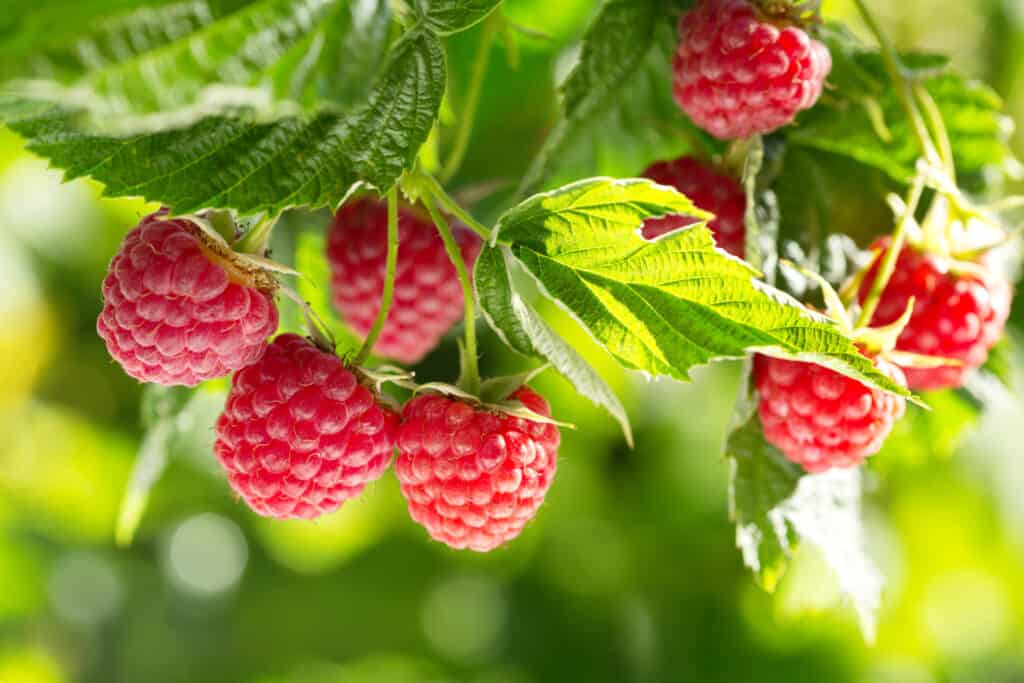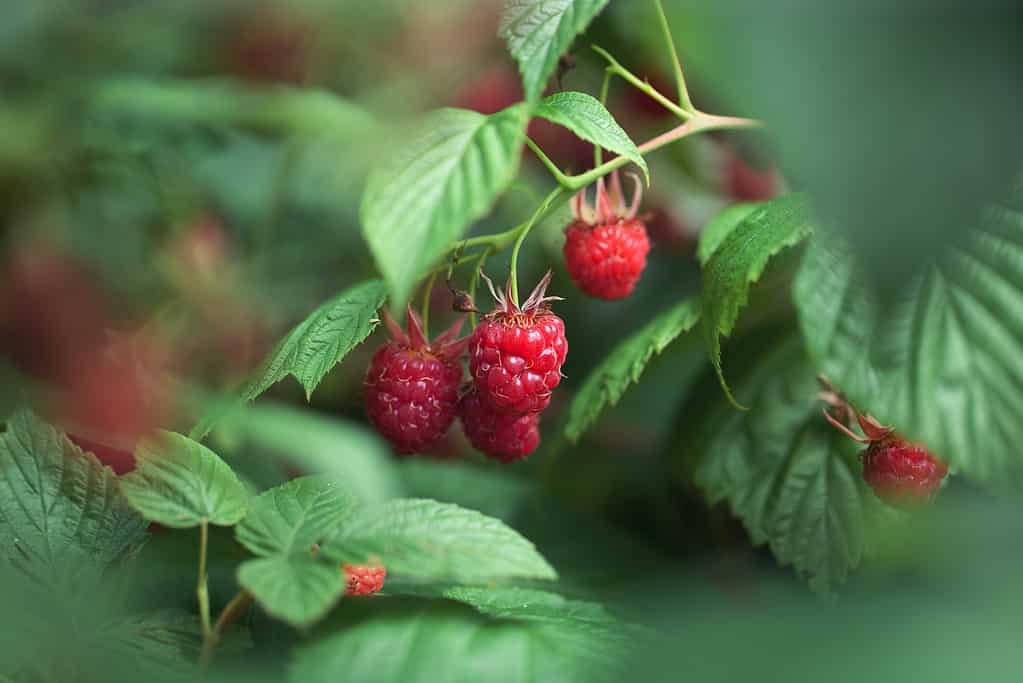Raspberries are incredibly versatile fruits. When you know how to produce raspberries for your own use, you can have a fresh dish of raspberries, create raspberry jam, or squeeze raspberry juice at your leisure. If you decide to grow your own plants at home, you can indulge in a few fresh berries right from the plant and freeze any leftovers you don’t need from your harvest right away.
Be sure to select the best raspberry variety for you, plant them in a location with enough sun, then cut them back regularly to ensure that they continue to bear fruit year after year. This will help your raspberry plants survive and yield quite a lot of fruit every year. In this guide, we’ll break down exactly how to grow raspberries at home and enjoy their yields for years to come.
The Botanical Name and History of Raspberries
Raspberries, also known as wild raspberries, are classified as Rubus idaeus. The genus Rubus, which is considered the rose family, contains many different plant species that are collectively referred to as raspberries. However, Rubus idaeus is the main species that is commercially grown worldwide and found in grocery stores.
Raspberries have woody stalks and are considered perennial plants. Raspberries are farmed for the fresh fruit market as well as for industrial processing into jam, juice, individually fast frozen fruit, and dried fruit that is used in many food products.
Raspberries are native to Asia Minor and were domesticated by the Roman agriculturist Palladius in the 4th century AD. In the first century BC, the inhabitants of Troy were said to have collected raspberries in the wild on the slopes of Mount Ida. In his account of red raspberries in 45 AD, Pliny the Elder said that the Greeks called the berry “Ida fruit” in honor of Mount Ida. Although berries were first collected from the wild, the plants were utilized for medical purposes rather than for food, especially in the treatment of eye and stomach conditions. During one archaeological investigation, raspberry seeds have been discovered at Roman forts in Britain, providing evidence that the Romans expanded raspberry cultivation throughout Europe. Raspberries are commercially grown around the world to this day. In 2020, raspberry production worldwide capped at nearly 900,000 tons.
The summer-fruiting and ever-bearing cultivars of raspberries are two distinguishing varieties of wild red raspberry plants. The ever-bearing variety of raspberries appeals to certain gardeners since, once established, these plants will produce fruit in early summer and once again in the fall. Raspberry bushes that bear fruit in the summer only have one harvest per year. The summer-fruiting cultivar, if established, will produce fruit in its second year on woody branches. A smaller crop of berries is produced in June by ever-bearing raspberry plants, and a bigger crop is produced in September.

Raspberries (pictured) have been grown by humans for medicine and foot since ancient times.
©Nitr/Shutterstock.com
Climate and Hardiness Zone Requirements for Raspberries
Raspberries can be grown in USDA hardiness zones four through eight. Raspberries can grow very well in places that have somewhat cool summers and winters that are not too harsh. Some varieties of raspberry, such as the Bababerry cultivar, have been bred to survive hotter climates.
When to Grow Raspberries
In general, raspberries should be planted in the early months of springtime or in the fall. Many varieties should be planted in fall specifically, depending on the hardiness zone in which they will be planted. If you’re growing your raspberries indoors, you can virtually plant them at any time provided they have access to the right temperature range and sunlight levels.
Starting Raspberries From Seed vs. Buying Adult Plants
Although it takes a little longer, growing raspberries from seed is very easy to do and considerably less expensive than purchasing raspberry plants at a local nursery or garden center. You can grow a large number of raspberries from seed, which will result in a plentiful crop of fresh raspberries when harvest time rolls around.
As mentioned earlier, the best time (generally) to plant raspberry seeds is in the fall since the cold winter weather encourages spring sprouting. For the same result, you can try putting your seeds in the refrigerator to mimic the natural overwintering process of raspberry plants.
A seed-starting tray, seed-starting soil or soil-less mix, a glass jar with a cover, and a paper bag should be gathered to start prepping your seeds. Harvest withered, overripe fruit from a healthy vine in the fall and put it in the paper bag. The berries should be cleaned of their seeds before being put in a glass jar with a tight-fitting cover. For 45 days, keep the seeds in the refrigerator.
A loamy seed-starting mixture should be added to the seed tray. After removing the dried berry remains from the surface of the jar, take the seeds out of the jar and scatter them over the soil. About an eighth inch of the mixture should be spread over the seeds before gently pressing them into the soil. Place the tray in a warm, sunny area after watering it until it is damp but not saturated with water. If you decide against stratification, you can leave the tray outside over the winter without watering it. After springtime temperatures have warmed up, water the tray and wait for sprouts to start appearing.
As the seedlings develop and grow, keep the soil moist as usual. Plant the seedlings in their permanent outdoor site when they are about inches tall.

It is generally recommended to try growing raspberries (pictured) from seed rather than an existing plant.
©iStock.com/Alex Sholom
How to Grow Raspberries
It’s so easy and enjoyable to grow your own delicious wild raspberries at home. And with the price of fruit these days, growing your own plants is definitely a smart choice. These bushes enjoy good soil, regular watering, and lots of direct sunshine, just like the majority of fruiting plants. While raspberry is a native of colder areas, it also thrives in conditions of moderate temperature and humidity. The first year after planting before the bush establishes itself and provides fruit is a period that requires special attention. Following that period, your raspberry patch will expand and develop new bushes every spring with little human intervention. Depending on the variety you grow, annual pruning could be necessary to maintain the health and manageable growth of your plants.
In only a few seasons, a patch of unattended raspberries can become untamed. And when they don’t have enough space or adequate ventilation to survive, these fruiting plants often perform badly in terms of fruit yields. To avoid this problem, be sure to space your plants eight inches apart each spring.
Soil and Fertilizer Requirements for Raspberries
The pH range of your raspberry plant’s soil should be 6.0 to 6.7, which is ideal for rich, well-draining soil that is slightly acidic. You can improve poor-quality soil by adding organic material to the mix right before planting. To prevent root rot, planting raspberries on raised beds also aids with drainage. Overly moist or dense clay soil is not conducive to the growth of raspberries.
Raspberries are quite heavy feeders that love fertilizer. Well-fertilized soil directly relates to your fruit yield, so this isn’t a step you should skip. Compost or good manure should be incorporated into your raspberry’s soil before planting to enhance soil structure and supply nutrients if you want to give them a productive habitat. Work humus, peat, and/or pine into naturally alkaline soil to raise its acidity levels. Once a system is in place, a yearly application of well-composted manure mixed with additional liquid fertilizer will be more than enough for established plants. For established plants, do this just once before June once a year, and for young plants, do this twice in the first year.
Water Requirements for Raspberries
For the raspberry plant to produce juicy fruit, it needs regular watering. In fact, during its growing season, it prefers around an inch of rainfall or water. Pay close attention to how much water your plants get throughout the first year as they establish themselves, and provide more water as necessary. You can keep track of rainfall totals in your garden by installing a low-cost rain gauge. If you don’t live in a rainy area, be careful to water raspberries from the soil since their leaves are prone to various fungi. Remember, dry foliage does not support fungus growth! Install a drip watering system if at all practicable, as this is the most efficient way to water these plants.
Temperature and Humidity Requirements for Raspberries
The raspberry plant is native to colder climates and enjoys moderate temperatures and humidity levels. Raspberry photosynthesis processes can stop when temperatures are too high. The ideal summertime temperature for this plant is between 70 and 75 degrees F. Make sure the planting area receives plenty of light and afternoon shade in warmer areas to help control the temperature around the plant and soil.
Sunlight Requirements for Raspberries
The optimal conditions for wild raspberry growth are moderate shade and sun. Throughout the growing season, this plant needs six to eight hours of sunshine daily and is susceptible to sunburns in hot, direct sunlight. The fruit’s quality won’t be impacted by a minor sunburn, but leaf burn can harm the appearance of your plant.
How Long Do Raspberries Take to be Ready for Harvest?
The development of raspberry bushes varies by cultivar and climate, but the majority of raspberries ought to be ready for harvesting around 18 months after planting.
Grab the berry but don’t squeeze; just give it a little pull to harvest. The fruit is ripe if it readily separates from the stem and the core is still attached to the plant. Avoid collecting all of the gathered fruit in one container if you have a large number of ripe berries at once; otherwise, you run the danger of having the berries squished.
Raspberry Companion Plants
Bumblebees and other bee species are the principal pollinators of raspberry bushes. Companion plants can aid in attracting these beneficial pollinators, as well as controlling soil-borne fungi like verticillium wilt. By deterring insects with their strong odors, alliums including onions, garlic, and chives work as a natural pesticide for raspberry plants. Just as well, preparing the soil for raspberry plants by planting cover crops like grains and grasses at the planting location beforehand is a terrific approach to nourishing the soil.
Raspberries are fun plants to grow at home, and their large yields are perfect for eating fresh or preserving. If you want to grow raspberry plants at home, all it takes is a little bit of care and some patience.
The photo featured at the top of this post is © Mike_O/Shutterstock.com
FAQs (Frequently Asked Questions)
Do raspberries take a long time to grow?
Raspberries can take about two years to produce fruit.
Do raspberries come back each year?
Yes, raspberries will come back each year, provided you will prune off the dead canes each winter.
Are raspberries hard to grow?
Not at all. These fruit brushes are easy to grow and produce a ton of fruit.
Thank you for reading! Have some feedback for us? Contact the AZ Animals editorial team.






